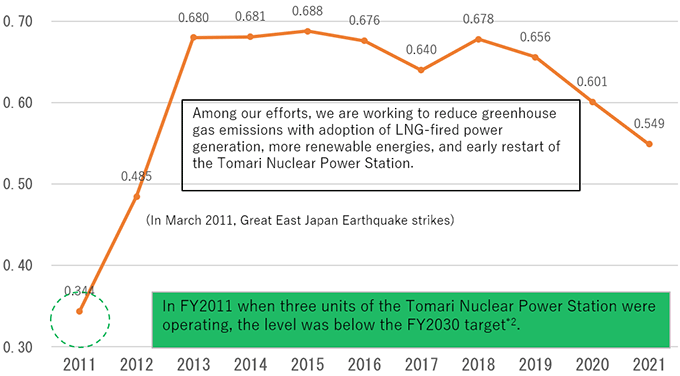Ensuring a More Competitive, Stable Power Supply and Contribution to Environmental Conservation
The Paris Agreement took effect in November 2016, and there has been greater interest in taking action to abate global warming. HEPCO joined the Electric Power Council for a Low Carbon Society, and has been implementing initiatives to abate global warming that are best suited to the characteristics of Hokkaido, while at the same time recognizing that it is fundamental to pursue an optimum energy mix from the "S+3E" perspective, which aims to concurrently achieve energy security, economic efficiency, and environmental compatibility on the premise that safety is assured.
HEPCO strives to further utilize the abundant renewable energies of our region, and has been working on projects to demonstrate the feasibility of large energy storage systems in order to control fluctuations in output, an important issue that needs to be addressed in order to increase the adoption of renewable energies. Combining renewable energies with the use of energy generated by nuclear power on the principle that safety is assured will contribute to making the low-carbon and the carbon neutral society a reality.
Specific Initiatives
| Power generation | |
|---|---|
| Nuclear power |
|
| Thermal power |
|
| Hydroelectric power (renewable) |
|
| Renewable |
|
| Retail | |
| Energy savings and CO2 reduction activities |
|
| Power transmission and distribution | |
|---|---|
| System interconnections HVDC |
|
| Networks |
|
| Renewable |
|
CO2 emission reduction targets for all electric power operators set by the Electric Power Council for a Low Carbon Society
| FY2031 |
|
|---|
*BAT: Best Available Technology
Change in HEPCO's CO2 Emission factor*1
- After the Great East Japan Earthquake, the Tomari Nuclear Power Station was gradually taken offline, which resulted in a significant increase in the amount of thermal power generated.
- The HEPCO groups have set the environmental target for 2030 as below. We will achieve the target through the restart of Tomari nuclear power station and the use of LNG thermal generation.
- CO2 emissions: Reduction by 50% + (or 10Mt + /year) from FY2014 levels.

- *1Value adjusted for CO2 credits and other measures
- *2Target sought to be achieved by the entire electric power industry.
Using nuclear and LNG-fired power to reduce CO2 emissions
Since the Great East Japan Earthquake, the long-term shutdown of the Tomari Nuclear Power Station has led to a significant increase in the amount of thermal power generated, for which coal and oil are used as fuel. This has dramatically increased HEPCO's CO2 emissions. We anticipate that restarting Tomari Nuclear Power Station upon the premise that safety is assured as well as stable operation of Ishikariwan Shinko Power Station which uses LNG as fuel will reduce our CO2 emissions in the future.
[Life-cycle CO2* emissions by power source]

Source: Central Research Institute of Electric Power Industry:
- *"Comprehensive Assessment of Life Cycle CO2 Emissions from Power Generation Technologies in Japan" (2016).
- *Includes not only CO2 emissions from power stations in the operational stage, but also emissions over a series of activities, including fuel mining, transport,processing, waste treatment and so on.